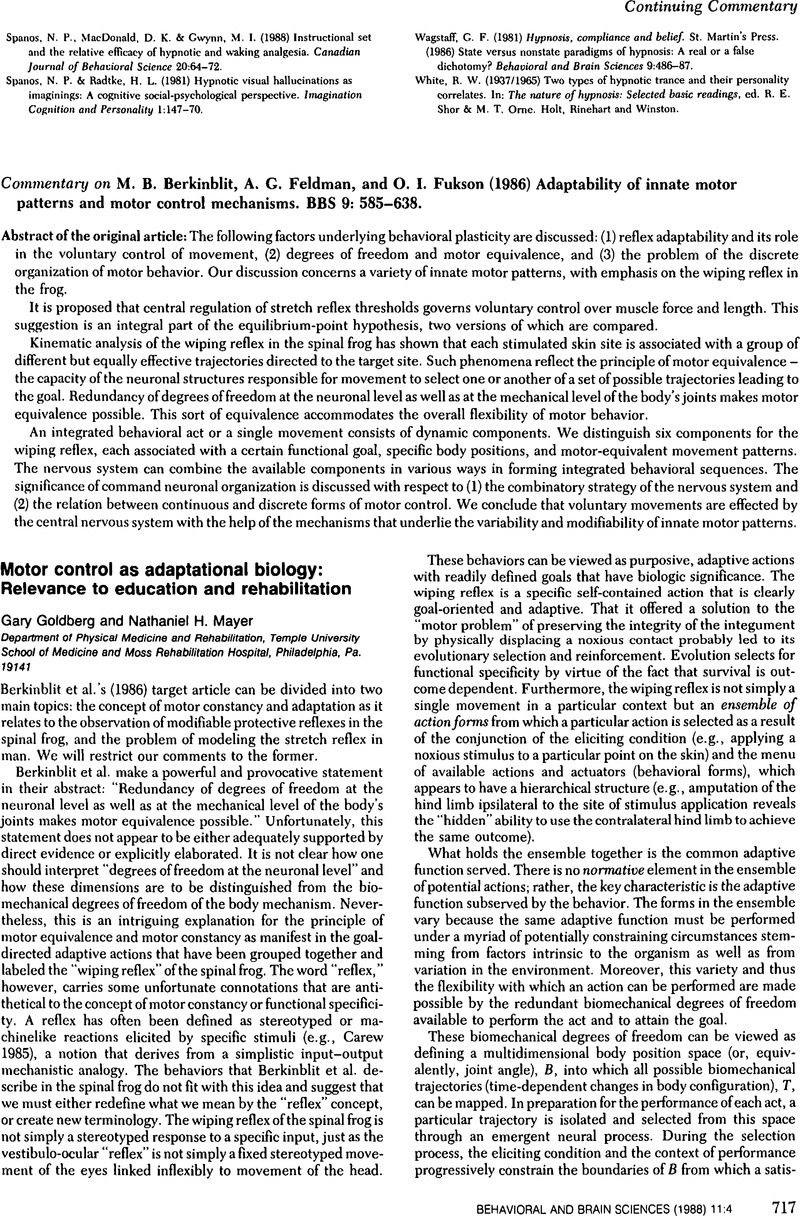No CrossRef data available.
Article contents
Motor control as adaptational biology: Relevance to education and rehabilitation
Published online by Cambridge University Press: 04 February 2010
Abstract
An abstract is not available for this content so a preview has been provided. Please use the Get access link above for information on how to access this content.

- Type
- Continuing Commentary
- Information
- Copyright
- Copyright © Cambridge University Press 1988
References
Berkinblit, M. B., Feldman, A. G. & Fukson, O. I. (1986) Adaptability of innate motor patterns and motor control mechanisms. Behavioral and Brain Sciences 9:585–638.CrossRefGoogle Scholar
Berkinblit, M. B., Feldman, A. G. & Fukson, O. I. (1986r) In search of the theoretical basis of motor control. Behavioral and Brain Sciences 9:626–31.CrossRefGoogle Scholar
Berkinblit, M. B., Gelfand, I. M. & Feldman, A. G. (1986) A model for the control of multi-joint movements. Biofizika 31:728–38.Google Scholar
Bernstein, N. H. (1984) Human motor actions: Bernstein re-assessed, ed. Whiting, H. T. A.. North-Holland.Google Scholar
Carew, T. J. (1985) The control of reflex action. In: Principles of neural science, 2d ed., ed. Kandel, E. R. & Schwartz, J. H.. Elsevier.Google Scholar
Davis, W. E. & Sinning, W. E. (1987) Muscle stiffiness in Down syndrome and other mentally handicapped subjects: A research note. Journal of Motor Behavior 19:130–44.CrossRefGoogle Scholar
Edelman, G. M. (1987) Neural Darwinism. The theory of neuronal group selection. Basic Books.Google Scholar
Flash, T. (1987) The control of hand equilibrium trajectories in multi-joint arm movements. Biological Cybernetics 57:257–74.CrossRefGoogle ScholarPubMed
Gelfand, I. M. & Tsetlin, M. L. (1967) Mathematical modeling of mechanisms of the central nervous system. In: Models of the structural-functional organization of certain biological systems, ed. Gelfand, I. M., Curfinkel, V. S., Fomin, S. V. & Tsetlin, M. L.. MIT Press.Google Scholar
Hasan, Z. (1986) Do subprograms for movement always seek equilibrium? Behavioral and Brain Sciences 9:609–10.CrossRefGoogle Scholar
Hogan, N. (1984) An organizing principle for a class of voluntary movements. Journal of Neuroscience 4:2745–54.CrossRefGoogle ScholarPubMed
Kelso, J. A. S. & Kay, B. A. (1986) Information and control: A macroscopic analysis of perception-action coupling. In: Tutorials in perception and action, ed. Heuer, H. & Sanders, A. F.. North-Holland.Google Scholar
Mishkin, M. & Appenzeller, T. (1987) The anatomy of memory. Scientific American 256:30–41.CrossRefGoogle ScholarPubMed
Nashner, L. M. & McCollum, G. (1985) The organization of human postural movements: A formal basis and experimental synthesis. Behavioral and Brain Sciences 8:135–72.CrossRefGoogle Scholar
Prosser, C. L. (1986) Adaptational biology: From molecules to organisms. Wiley Interscience.Google Scholar
Reed, E. S. (1984) From action Gestalts to direct action. In: Human motor actions: Bernstein re-assessed, ed. Whiting, H. T. A.. North-Holland.Google Scholar




